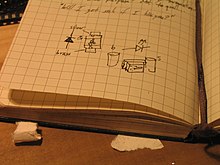Notebook
A notebook is a book with blank pages that is used to collect ideas, remarks and notes of all kinds.
description
There are many types of notebooks, as ring binders , with adhesive binding , stapled, bound or as loose-leaf collections with clamping devices, lined, checked or completely white, depending on the purpose and preferences. Two particularly well-known forms of the notebook are the Moleskine and the CIAK , which are often associated with writers and artists and are subject to a certain object cult .
The notebook can a simple form in the booklet are performed for a particular purpose. In school, for example, special exercise books are used that are used to write down homework. The notebook differs from the diary in that it usually takes factual notes in which chronology and personal experience play an insignificant role. It differs from the journal in that the notes are not bound by subject.

Many creative people consider the notebook to be an indispensable aid for intellectual work. It is reported that Leonardo da Vinci (1452–1519) always wore such a book on his belt. Theodor Fontane (1819–1898) used notebooks for his poetic, journalistic and travel literary work. They functioned as books on the go, as a store of ideas and as an archive. While he was a prisoner of war, his notebook with his private notes saved him from execution. Bruce Chatwin (1940–1989) is quoted as saying that losing his passport is a triviality compared to the catastrophic loss of his notebooks: "To lose a passport was the least of one's worries: to lose a notebook was a catastrophe."
As part of creative writing , the notebook is recommended so that you can write down an inspiration at any time before the writing impulse that is so important for the writing process can be lost. Roger von Oech, the founder of Creative Think, tells in his book The Creative Kick of a case in which a sheet of cling film was used as a surface for notes with grease pencils even under the shower.
Reusable forms
In addition to simulated notebooks on smartphones and tablets, there are also notebooks whose content can be digitized using the camera of a smartphone. The notes can then be deleted to make new space.
The advantage is
- low material consumption, since no additional paper is used, and
- the possibility of classifying what has been photographed using an app and forwarding or storing it via various cloud or email services
The pages are not made of paper, but made of coated material with a very smooth surface.
There are pages with lines, blank pages, but also complete calendar or address book forms. There are A4 to A6 versions.
Frixion
It is written with pens with special ink that is generated by heat, e.g. B. by rubbing with a microfiber cloth or eraser , but also with special heating devices (or a hair dryer) becomes invisible or transparent. If the ink is not really removed, the cold can make it visible again.
Examples:
- Rocketbook
- Elfinbook
- Homestec
Non-permanent markers
As on a whiteboard , you write with erasable pens
Examples:
- Bambook
- Esquoia
In the literature
The notebook was used as a literary genre by Doris Lessing , first in one of her best-known works, the Golden Notebook (1962). As part of the hybrid form of her last work Alfred and Emily (2008), the notebook returns.
See also
- Hypomnema , notebook
- Leonardo da Vinci's manuscripts
- The golden notebook , a novel by Doris Lessing from 1962
- The red notebook , book by Paul Auster from 1995
- Google notebook
- LTI - a philologist's notebook
literature
- Gabriele Radecke : Notebook Editions. On the philological concept of the genetic-critical and annotated hybrid edition of Theodor Fontane's notebooks. In: editio 27 (2013), pp. 149-172.
- Michael Rutschky : Before writing. Via note calendar. In: Merkur 56,6 (June 2002), pp. 480-493.
Web links
Individual evidence
- ↑ Stefan Klein: Da Vinci's Legacy . Fischer Taschenbuch, Frankfurt am Main 2009, ISBN 978-3-596-17880-3 , pp. 11-13.
- ↑ Cf. Theodor Fontane: Digital genetic-critical and annotated edition of Theodor Fontane's notebooks. Edited by Gabriele Radecke. Göttingen 2015 ff., Available online at: https://fontane-nb.dariah.eu/index.html
- ↑ Cf. Theodor Fontane: Prisoners of War. Experienced in 1870. R. v. Decker, Berlin 1871.
- ↑ Bruce Chatwin: The Songlines. Penguin, Harmondsworth 1988 (new edition), ISBN 0-14-009429-6 , p. 160.
- ↑ Roger von Oech: The creative kick . Junfermann, Paderborn 1994, ISBN 3-87387-098-3 .
- ↑ Homepage of the Rocketbook provider. Retrieved December 10, 2019 .
- ↑ Homepage of the Elfinbook manufacturer. Retrieved December 10, 2019 .
- ↑ Homepage of the Bambook organization. Retrieved December 10, 2019 .
- ↑ homepage Esquoia notebooks. Retrieved December 10, 2019 .
- ^ Virginia Tiger: Life Story: Doris, 'Alfred and Emily'. In: Doris Lessing Studies , Vol. 28, No. 1, 2009, pp. 22-24.
